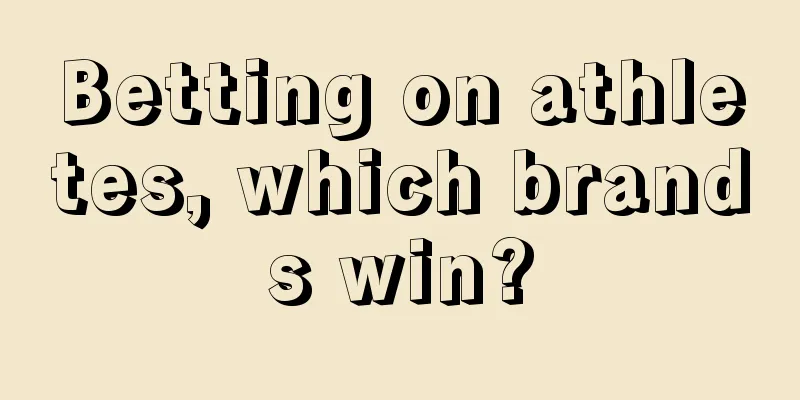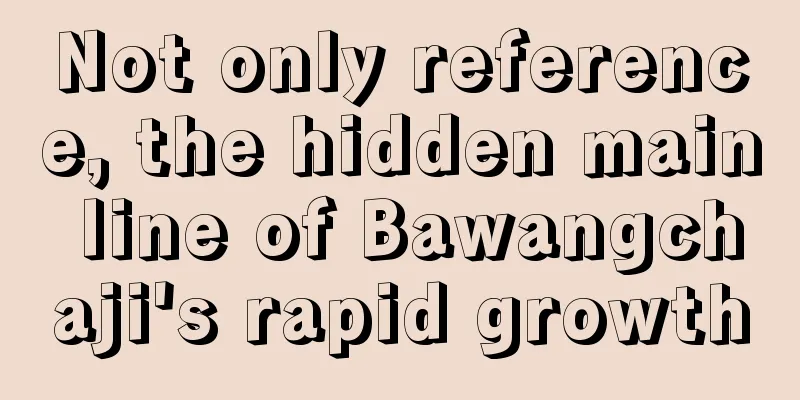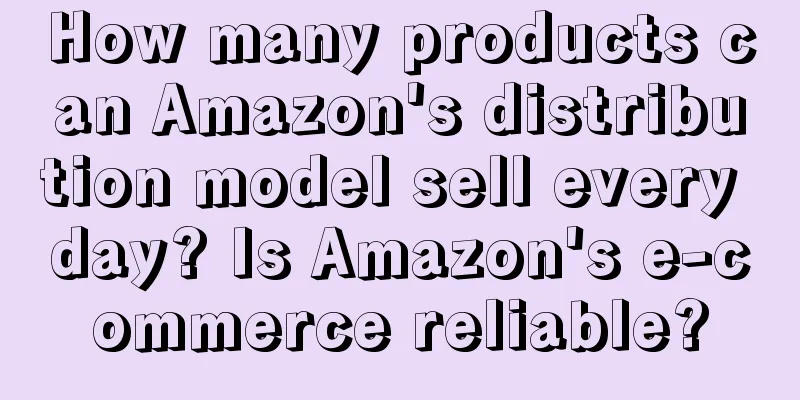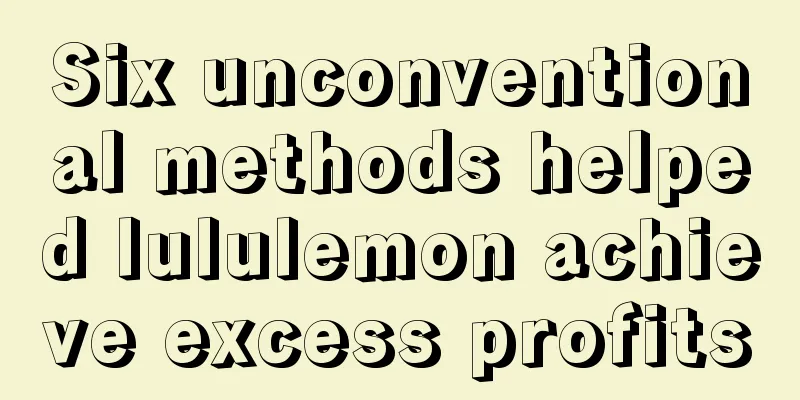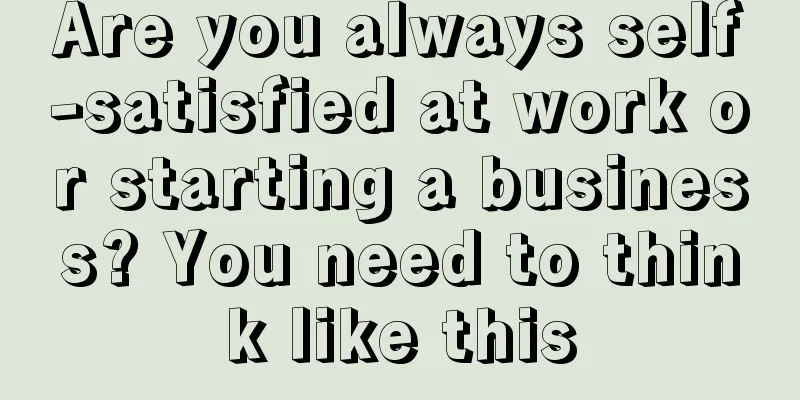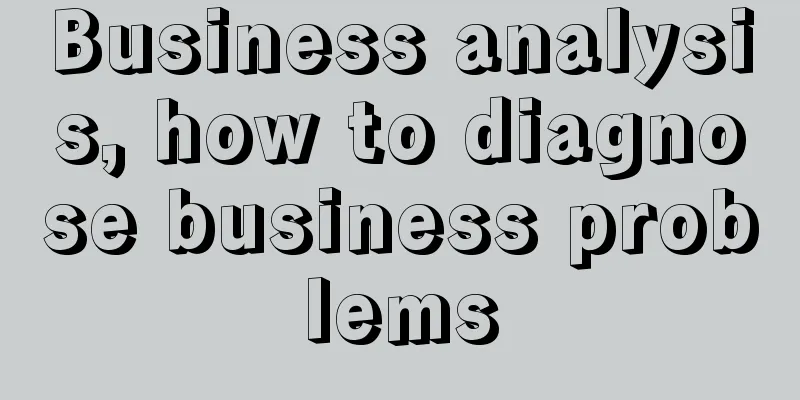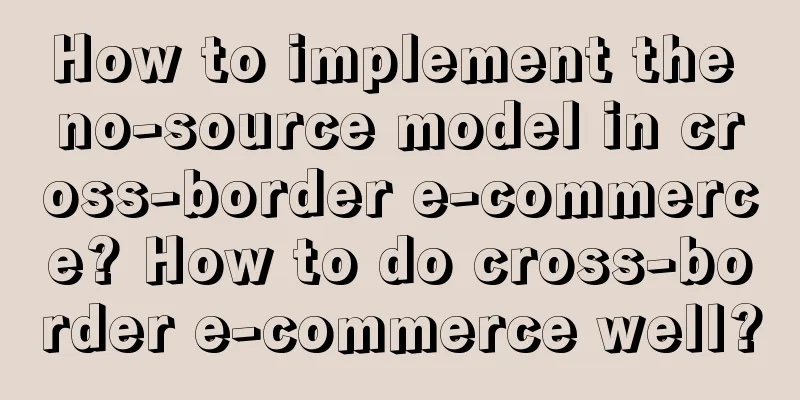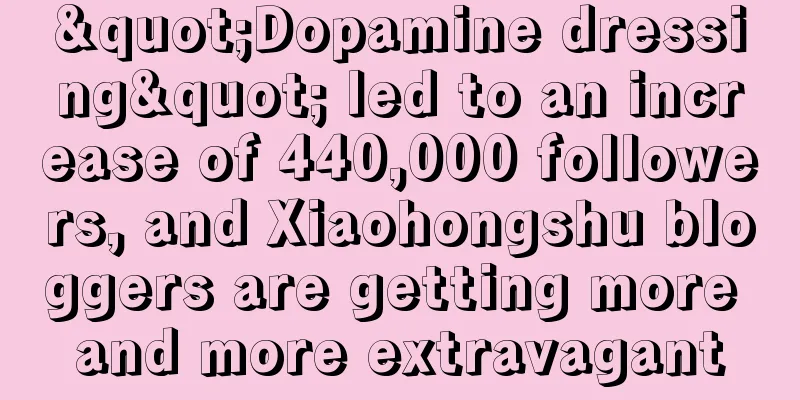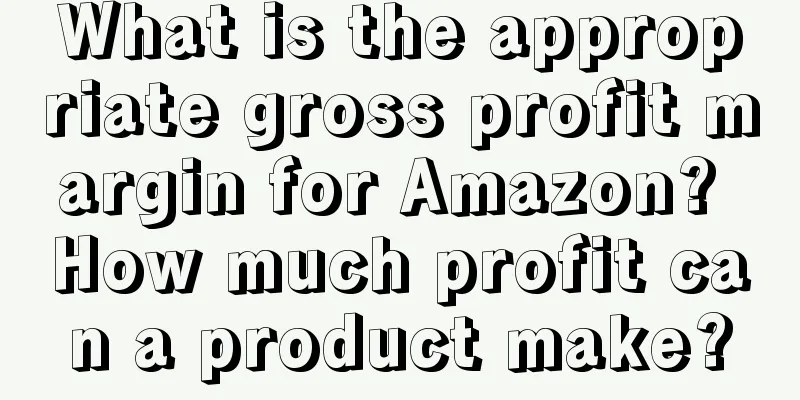[Mid-year review] Frontline traders’ in-depth thinking on marketing
![[Mid-year review] Frontline traders’ in-depth thinking on marketing](/upload/images/67e6f728bcf86.webp)
I went to a new company to take over new business in December last year, and have been exploring growth in traffic and new additions. During the same period, Yuruhemao also had some exchanges and co-creations with many brands and institutions at the business level. The most notable experience of doing marketing this year is: The macro environment remains difficult, consumption is not driven by internal factors, the market is seriously involuted, and many new consumer brands have collapsed rapidly; At the micro level, many new strategies and new cases have emerged: Douyin Xiamen Gang, Xiaohongshu private messages and closed-loop e-commerce, and video account live streaming sales. In the past six months, since Yu Ru took over, our business has increased by 15% year-on-year, and the number of new users has increased by about 50% year-on-year. To quote Diao Ye: "We are surviving in an era without textbooks. It is both dangerous and fun. It is also full of huge opportunities." The method of one set of global positioning is not so effective anymore (there is not enough money to spend), and everyone is saying: we need to develop a marketing plan of "crowd assets + content strategy + global operation" . So, how do we find the right audience, how do we allocate budgets, how do we formulate content middleware strategies, and how do we customize effective conversion content for different media? After six months of practice, the most profound experience I have gained is: We cannot just treat the symptoms without addressing the root cause. Instead, we must adapt to the changes, truly change our marketing ideas, and re-formulate a global strategy that includes "who to talk to" + "where to talk" + "what to say" . In today’s article, let us start from the most profound change and introduce you to a new set of marketing planning ideas and strategies. 1. Changes in the nature of marketing: from the search era to the information flow eraLet's get one thing clear first: What are brands fighting for? In the past, the competition was about user demand. Brands compete to become the "best solution to a certain need". Whether it is positioning, differentiation, or market segmentation or vertical population, it is a competition around specific needs. But now, consumers are consciously holding on to their purse strings and suppressing their purchasing demands, telling themselves "don't buy if you can avoid it, buy cheap if you can, wait if you can, and endure if you can", resulting in the shrinkage or even collapse of many demands, from cars and houses to beauty products, clothing, digital products and even daily necessities. However, rigid, daily habitual demands face extremely fierce competition in both traffic and price. The demand gold mine is no longer enough to be divided, and we must dig deeper to the "motivation" layer - it doesn't matter if you don't have demand, but if the motivation is triggered, it can still be converted into demand to stimulate action. The essence of marketing is shifting from "competing for demand" to "competing for motivation." The typical representative of the era of demand is search (whether it is mental ranking, first association, or the behavior of searching on Baidu or purchasing in the supermarket, all belong to search in a broad sense - competing with each other in the existing demand pool to make oneself the customer's "solution") The typical representative of the motivation era is information flow , that is, in scenarios with relatively weak demand or even no explicit demand, the interest and consumption willingness of target users can be gained by stimulating motivation. Motivation is king, which means moving from the era of search to the era of information flow. Although Douyin and Xiaohongshu have been vigorously promoting their own search products since last year, the results have been quite good. But whether it is the Little Blue Words or the return search, a large part of them belong to "search after reading", that is, the motivation comes first and the search comes later. Baidu has been focusing on e-commerce for a while, and at that time it put all its efforts into it, but the core logic was still based on search, including directing search results to e-commerce channels, or fine-tuning the labels of search groups to reach information flows. However, the absolute volume of searches is declining, and these methods have not really played a role. Moreover, the people who meet the corresponding search needs will subconsciously look for the most cost-effective solution. Compared with more mature e-commerce platforms, Baidu may not be able to provide the most cost-effective products and services. From digging deep into demand to stimulating motivation, it is not only a change in the form of delivery, but also a change in the overall marketing thinking, building a new marketing chain driven by motivation:
2. Digging deeper into the motivations behind crowd labelsIn the search scenario, the crowd targeting is very clear, that is, facing potential purchasing users with high intention; while the information flow scenario is much more complicated, and each platform has a set of crowd targeting logic. The more common practice at present is to target according to the population labels assigned by the platform, such as the eight population groups of Tmall and Douyin, and the 20 lifestyle population packages of Xiaohongshu, and then add more segmented population attributes and consumption attribute labels to lock in core potential consumers. However, are labels really useful? If the market is very involuted, using labels that seem to fit well will attract traffic from competitors today, and competitors will attract your traffic tomorrow... Therefore, you might as well try another approach of "finding the crowd" and dig into the deeper motivations through the superficial labels. To put it simply, it means starting from the customer's perspective and inferring the "people most likely to buy." We have previously cited the example of the girlfriend phone. The target group with the best data is not the "sophisticated moms" or the "senior middle class", but the "medical beauty consumers". The reason is that they are curious about and willing to try high-priced new products. To explore consumer motivations, we must not only understand "what the purchase is based on" , but also get to the bottom of "why there is this demand" . To clarify this, we can start from two aspects: subjective and objective: 1. Conduct analysis from a subjective perspective, including the user’s life stage, the most important issues they face, their inner concerns, consumption intentions, and decision-making preferences. 2. Objective dimension: Collect data and information, mainly including:
3. A global layout based on motivation driveThe underlying logic of motivation-based traffic layout is: According to different motivations, different content and platform combinations are matched. For example, the motivation for job hunting can be divided into the following categories from weak to strong:
Many people think that "wanting to find a job" is equivalent to people who are looking for a job, but in fact, almost all people in the workplace are interested in "better opportunities"; and the proportion of people in the workplace who are "not satisfied with the current situation" is also high. These people also have the motivation of "wanting to find a job" - for job-seeking apps, does this mean that the size of the entire population has expanded? After distinguishing different levels of motivation, the next step is to combine content and channels, as well as corresponding products and services according to different motivations. Each of the above contents and combinations is the optimal cost-effective model we have explored in practice. For example, why should we choose content such as Douyin drama experts for "unsatisfied people in the workplace"? The reason is: this group of people are not very motivated to find a job. When they are in a state of entertainment and relaxation, you can make a "little reminder" to make them interested in a certain function or skill (related to job hunting), rather than listening to the output of workplace experts or life mentors - because they are not in a hurry to find a job, so they don't have the patience to listen to long speeches. For those who are looking for a job, the latter is often more valuable content. The above is also the conclusion we have drawn through continuous testing and deduction - to truly master the "motivation model" (content + media) corresponding to each specific product and service, we must be deeply involved in the business and continue to explore, trial and error, and iterate. Let me add one more thing here. Many brands will believe in the advice of masters, but if the "masters" are not in charge of specific marketing business at the moment, it is easy to be out of touch with marketing reality. After all, things are changing too fast. Unless you already have an absolutely overwhelming budget or a deep-rooted channel layout. However, at this time, it is not so important to have the guidance of a master or not. 4. A Complete Motivation Expression FormulaAfter planning the population and channels, how can we effectively convert users? In the era of demand, it is only necessary to point out the competitive advantages or differentiated selling points of the product; in the era of motivation, a complete set of motivation expression formulas is needed: Motivation formula = motivation induction + product role + elimination of guilt 1. MotivationHow to effectively induce motivation, here is a simple model: The more urgent the need for a product is, the more it needs to be guided by negative motivations, such as fear, guilt or anxiety. This has been mentioned in our offline courses on Xiaohongshu: the more precise and urgent the needs of the group, the more "horror-type" content is needed to stimulate a strong desire to buy . For example, when promoting foundation products on Douyin, it is often necessary to construct an "awkward" scenario, such as when the makeup suddenly comes off during a blind date, a meeting with a love rival, or an important banquet, which is very embarrassing, in order to arouse purchasing intention. Products that are not just for basic needs often need to create a sense of yearning, inspire positive emotions, and provide beautiful life samples and life advice to stimulate the desire to own them. Note that when using positive motivations, the more expensive the product or service, the further away from everyday life it should be. For example, luxury goods often require "dream creation"; and the cheaper and more frequent it is, the closer it should be to daily life . Last month, we participated in a discussion on the promotion of a new low-alcohol beverage. The brand proposed many scenarios, such as travel bloggers getting tipsy in beautiful scenery and professional bartenders using the product to mix cocktails. These scenarios seemed very appealing, but they were too high above daily life and could not be associated with high-frequency consumption in daily scenarios. On the contrary, if low-alcohol wine is regarded as a "more interesting drink" and serves as a companion to daily dinners, midnight snacks, and TV series, it can be integrated into daily real life to a greater extent, allowing target users to immediately feel involved in drinking at home. 2. Product RolesThe product role is a key link between the past and the future. The connection between the past and the future must be closely related to the motivation, and the transition between the past and the future must be able to trigger user actions. In a podcast episode of "Talking to Cats", Yu Rui talked with a Xiaohongshu operator about "how to effectively promote products on Xiaohongshu". She said that when promoting a certain mobile phone (mainly for photography), they should never use fashion or beauty-related KOLs. The reason is that, although "making oneself look beautiful" is the underlying motivation, the rationality of "becoming beautiful through makeup" and "becoming beautiful through dressing up" is obviously stronger than "buying a mobile phone to take more beautiful selfies", especially for bloggers who are good at makeup or dressing up. People will focus more on how to put on makeup or how to dress up when "wanting to become beautiful". The product must be the first association after motivation is induced. If you fail to do this, you may end up doing things for others in vain. It would be best if it is a natural and reasonable combination of motivations. If this is not possible, another way is that this product service is the "minimum cost" to undertake the motivation . The “minimum cost” can be : There is a brand that focuses on "emotional fragrance", using the beautiful imagination brought by fragrance as an inducement, but the product is not perfume or household fragrance, but enzyme laundry detergent - although it is not the first association, it has an absolute price advantage and can also be strongly associated with motivation. It can also be energy cost : For example, Maimai mainly promotes social networking: there are various ways to gain connections: dinner parties, cocktail parties, joining groups, asking for help from mutual friends, etc. But what if you are "waiting for others to find you"? ——When you open Maimai, you only need to fill in your resume information, and various former colleagues, alumni, HR and headhunters will send you private messages. Isn’t this way of "making connections while lying down" more attractive? If your products and services appear to cost very little, they are more likely to generate motivation and trigger corresponding behaviors, such as searching and purchasing. 3. Eliminate GuiltAs a friend from Alibaba Mom Research Institute said: "In the past era of economic boom, the focus of brands was to increase desire, but now the breakthrough is to dispel concerns, reduce the guilt of spending money, and use good experience and emotional value to offset the anxiety and uneasiness caused by cash flow losses." So, how to offset the concerns and guilt about spending money. Through practice, we have also extracted four key elements:
1 and 2 are easy to understand, such as limited-time offers, same-day discounts, limited places, and out-of-print limited quantities; 3 is also a commonly used method, especially for high-priced products, which means that "high-frequency use" can offset some of the concerns about spending a lot of money. Let's mainly talk about the fourth point: Using "reverse psychology" is an effective way to help consumers "overcome psychological barriers." That is, convert the "internal pressure that may be faced into external, visual pressure" and then use "self-affirmation" to fight against this pressure. For example, if I buy myself a very expensive speaker or action figure, I sometimes worry that my family members will complain about me spending money indiscriminately, or that I will feel guilty about it. At this time, you can explain in the content, "When I bought it, my mother-in-law and husband said I was spending money recklessly, but I was willing to please myself. What's wrong with spending my own money?" or "My family thought it was better to buy the cheaper one, but I insisted on buying the expensive one, and it turned out that I was right." Everyone has a rebellious heart. Assuming a character that can be confronted can stimulate purchasing intention to a greater extent through rebellious psychology. To summarize, the complete motivation expression formula is: Final ThoughtsIt is undeniable that the difficulty of marketing has greatly increased as we move from the era of demand to the era of motivation: it requires not only a full exploration and digging of users' deep psychological motivations, but also a thorough understanding of the platform's characteristics and user browsing habits, and self-iteration through continuous testing. But a motivation-driven marketing model also means: there is much more room and flexibility. Not only can we explore a larger user pool, but we can also flexibly match and even redesign products and services based on different motivations to optimize the overall business model. I hope the above content can provide some reference and help to marketing operators. Author: Lanlan, WeChat public account: Taro and Cat Talk |
<<: How does toy marketing empty the wallets of adults?
Recommend
How to detach the Amazon child from the parent? What is the method?
More and more merchants are opening stores on Amaz...
Where is the Amazon return address? Will the return address be associated?
Whether you are a buyer or a seller, you need to s...
Can I apply for early payment from Amazon? How long does it usually take to get the payment back?
Just like the rules of Taobao platform, the money ...
How to search for other people’s stores on Amazon? How to operate it well?
Therefore, as the Amazon platform continues to gro...
Copy homework! Teach you how to build an operations analysis system step by step
The analysis of a single operational action is cer...
10 insightful sentences
This article selects 10 sentences that go deep int...
How long will the Black Friday discounts last in the US? When will Black Friday be this year?
Every year after Thanksgiving, the United States w...
Xiaohongshu Beauty Operation: How four popular products went from 0 to 1 in half a year, revealing the content strategy that triggered sales!
Recently, a number of eye-catching products have e...
Ele.me’s New Year Marketing: The most beautiful phrase for the Chinese New Year: I’m here!
Touching people with emotions is a simple way to i...
Who will become the "second Lei Jun"? Let's talk about the six major schools of bosses who become Internet celebrities
Now many CEOs of companies have begun to shape the...
Discussing cost performance
When choosing products or services, you need to co...
Messi sells wine to "send blessings", will fans respond?
What kind of sparks will emerge from the cooperati...
Amazon opens Buy with Prime service to all merchants in the US
Amazon recently announced that it will open its Bu...
Xiaohongshu’s strategy to break the brand circle
On Xiaohongshu, a platform full of creativity and ...
Pinduoduo operation skills
This article shares some Pinduoduo operation skill...
